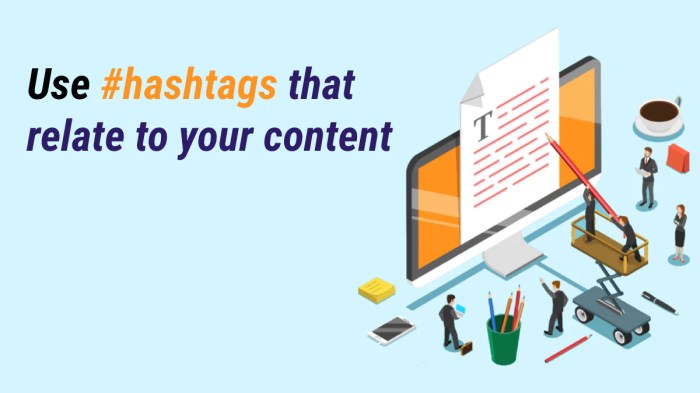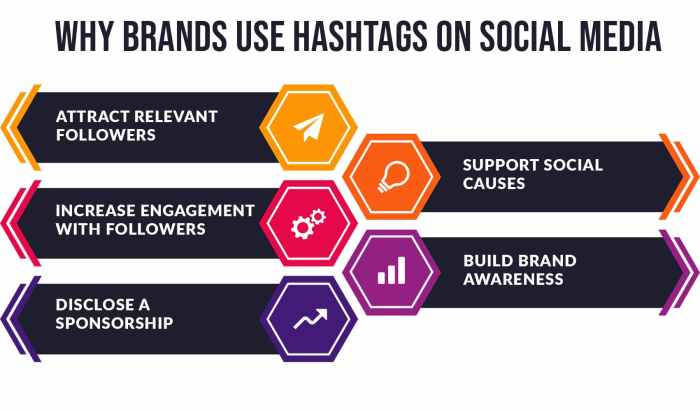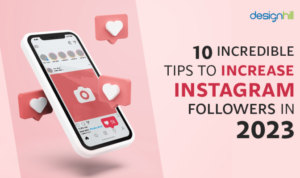Using Hashtags Effectively opens the door to a whole new world of social media strategies, where the right tags can make or break your online presence. From trending to niche hashtags, get ready to dive deep into the art of hashtagging!
In this guide, we’ll explore the different types of hashtags, how to create effective ones, best practices for using them, and common mistakes to avoid. So buckle up and get ready to revolutionize your social media game!
Introduction to Hashtags
Hashtags are words or phrases preceded by the “#” symbol used on social media platforms to categorize content and make it easier to discover. They serve the purpose of connecting users with similar interests and facilitating content searchability.
Hashtags have come a long way since their inception in 2007 on Twitter by Chris Messina. Initially, they were used to group related tweets together. Over time, hashtags have evolved to become a powerful tool for social movements, marketing campaigns, and trending topics.
Popular Hashtags and Their Impact
- #ThrowbackThursday: A hashtag commonly used to share nostalgic photos or memories on Thursdays. It has become a popular trend on various social media platforms, encouraging users to reminisce about the past.
- #BlackLivesMatter: This hashtag gained widespread attention as part of the movement advocating for racial equality and justice. It sparked global conversations and brought awareness to important social issues.
- #InfluencerMarketing: An example of a hashtag used in marketing campaigns to promote products or services through influencers. It has reshaped the way brands engage with their audience and drive sales.
Types of Hashtags
When it comes to using hashtags effectively, it’s important to understand the different types that can help boost your social media presence. Let’s break down the three main types: trending, branded, and niche hashtags.
Trending Hashtags
Trending hashtags are topics or s that are currently popular on social media platforms. These can range from current events to viral challenges. By using trending hashtags, you can increase the visibility of your posts and join conversations that are already happening online. For example, during major events like the Super Bowl or award shows, hashtags related to these events tend to trend. Utilizing these hashtags can help your posts reach a wider audience and increase engagement.
Branded Hashtags
Branded hashtags are unique to a specific brand or campaign. These hashtags are created to promote brand awareness, encourage user-generated content, and foster a sense of community among followers. For instance, Coca-Cola’s #ShareACoke campaign encouraged customers to share photos with personalized Coke bottles, generating a significant amount of user engagement. By creating your own branded hashtags, you can make your brand more recognizable and connect with your audience on a deeper level.
Niche Hashtags
Niche hashtags are specific to a particular industry, interest, or community. These hashtags may not have as high of a volume of posts, but they are highly targeted and can help you reach a more engaged audience. For example, if you are a fitness influencer, using niche hashtags like #FitFam or #HealthyLiving can help you connect with individuals who are passionate about health and wellness. Incorporating niche hashtags into your posts can attract a more relevant audience and increase the likelihood of meaningful interactions.
Remember, it’s essential to use a mix of different types of hashtags in your posts to maximize their effectiveness. By incorporating trending, branded, and niche hashtags strategically, you can expand your reach, increase engagement, and grow your social media presence. So, don’t be afraid to experiment with various types of hashtags to see what works best for your content and audience.
Creating Effective Hashtags
When it comes to creating effective hashtags, it’s essential to do your research and choose relevant tags that will help your posts reach the right audience. Here are some tips to help you create unique and engaging hashtags while also discussing the optimal number to use in a post.
Research and Choose Relevant Hashtags, Using Hashtags Effectively
- Start by researching popular hashtags in your niche or industry to see what’s trending and what your target audience is using.
- Look at what hashtags your competitors are using and analyze which ones are driving engagement.
- Consider using tools like Hashtagify or RiteTag to discover related hashtags and their popularity.
- Choose hashtags that are specific to your content but also broad enough to reach a larger audience.
Tips for Creating Unique and Engaging Hashtags
- Avoid using generic hashtags that are overly saturated with posts as your content may get lost in the sea of other posts.
- Be creative and come up with hashtags that are catchy, relevant to your content, and spark curiosity.
- Consider incorporating trending topics or current events into your hashtags to increase visibility and engagement.
- Mix and match different elements like puns, emojis, or wordplay to make your hashtags stand out.
Optimal Number of Hashtags to Use in a Post
- While there is no hard and fast rule, it’s generally recommended to use between 5-10 hashtags per post on platforms like Instagram and Twitter.
- Using too many hashtags can make your post look spammy and decrease engagement, so focus on quality over quantity.
- Experiment with different numbers of hashtags and monitor your post’s performance to see what works best for your audience.
Best Practices for Using Hashtags

Using hashtags effectively on different social media platforms is crucial for reaching a wider audience and increasing engagement. Here are some guidelines to help you make the most out of your hashtag strategy.
When to Use Popular vs. Niche Hashtags
- Popular hashtags: These are hashtags that have a high volume of usage. They can help you reach a larger audience, but the competition is also higher. Use popular hashtags when you want to increase visibility and reach a broad audience.
- Niche hashtags: These are hashtags that are more specific and targeted. They may have lower usage but can help you reach a more engaged and relevant audience. Use niche hashtags when you want to connect with a specific community or target a particular interest group.
The Importance of Monitoring Hashtag Performance
- Track hashtag performance: It’s essential to monitor how your hashtags are performing. Keep an eye on metrics like reach, engagement, and click-through rates to see which hashtags are driving the most results.
- Adjust strategies accordingly: Based on the performance data, adjust your hashtag strategy as needed. If certain hashtags are not performing well, try replacing them with others that are more effective. Continuously optimize your hashtag usage to maximize results.
Hashtag Mistakes to Avoid: Using Hashtags Effectively

When it comes to using hashtags, there are some common mistakes that people often make. Avoiding these mistakes can help you effectively reach your target audience and increase engagement on your posts.
Using Too Many Hashtags
- Using too many hashtags in a single post can come off as spammy and annoying to your followers.
- Limit your hashtags to a few relevant ones that truly represent the content of your post.
- Quality over quantity is key when it comes to using hashtags.
Not Researching Hashtags
- Using irrelevant or trending hashtags without understanding their meaning or context can harm your brand image.
- Research hashtags before using them to ensure they are appropriate for your content and target audience.
- Avoid using banned hashtags that could result in your post being shadowbanned or hidden from users.
Overusing Unrelated Hashtags
- Avoid using hashtags that have no connection to your post just to gain visibility.
- Using irrelevant hashtags can attract the wrong audience and decrease engagement on your posts.
- Make sure your hashtags are directly related to the content you are sharing.
